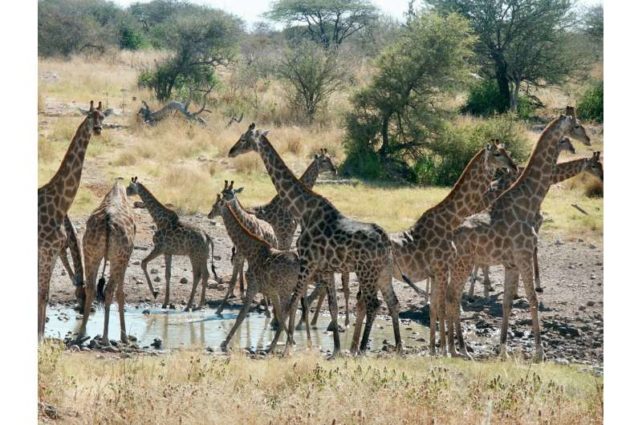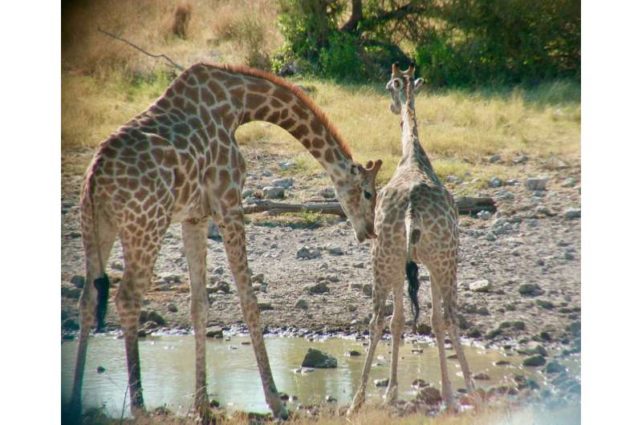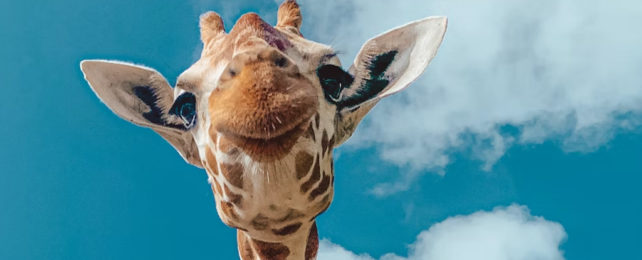If you think you have trouble telling when someone's into you, just be grateful you're not a giraffe.
Like many even-toed hoofed animals such as goats and antelope, male giraffes need to analyze a female giraffe's pee to figure out if they're receptive to baby-making.
Unfortunately reaching the ground to sniff at puddles of urine isn't the easiest thing to do when you're several meters tall. So males must convince females to urinate first, and catch the waste fluid mid-stream with their mouth.
Keep that in mind next time you roll your eyes while swiping left.
The secrets of giraffe sex lives, as well as a possible grieving ritual have been described by UC Davis veterinary scientists Lynette Hart and Benjamin Hart in a new observational study.
"They don't risk going all the way to the ground because of the extreme development of their head and neck," says Lynette Hart.
So the Harts observed these highly social animals gathering at the Namutoni waterholes, Etosha National Park in Namibia, to see how they compensated for this. Here they witnessed males investigating a female 102 times.

"They have to nudge the female," explains Hart," effectively saying, 'Please urinate now.' And often she will. He has to elicit her cooperation. If not, he'll know there's no future for him with her."
To do this, the towering male nuzzles or taps the rump of the slightly smaller female. In some cases, he might simply hang about waiting nearby. Some females in heat will wait until a male is close to pee.
Once the male giraffe slurps some urine into his mouth he raises his head, sometimes spitting a stream from his mouth like a practiced wine snob, grimacing to allow the urine to pass through a specialized opening in the mouth's roof into what's known as the vomeronasal organ.
By this he assesses the pheromones to determine if the female is receptive to his advances.
Other ungulates' vomeronasal organs have pronounced connections through their nose as well as mouth, but for giraffes the nasal connection is limited – an example of how their other anatomy has changed along with their extreme height.

The researchers also heard examples of giraffe warning growls. Giraffes were once thought to be silent but have recently been shown to cough, whistle, grunt, and even eerily hum to each other at night.
As if witnessing the intimate relations of giraffes in lust wasn't enough, the Harts observed a steady procession of the animals file by to examine one of their own dead, seemingly in mourning.
It's important not to anthropomorphize the animals, of course. After all, as the Harts speculate, they could have been looking for bones to chew.
They noticed these giant herbivores gnawing on bones almost every day of their observations. While this macabre behavior, called osteophagia, has been seen before, it was thought to be rare. Why occurs it in giraffes at all is unknown but other herbivores use it to increase their calcium intake.
It appears to be a risky thing to do though – several giraffes ended up getting the bones lodged in their mouths and were unable to remove them.
"People love watching giraffes," notes Benjamin Hart. "I think the more the public understands about them, the more interested they'll be in their conservation."
Let's hope so, as this rare remaining example of megafauna continues to decline in numbers thanks to the usual suspects of habitat loss, poaching and ecological change.
In 2016 a study identified their numbers had plummeted by up to 40 percent in 30 years, which saw giraffes officially listed as vulnerable on IUCN's threatened species list.
Maybe knowing their appearance isn't the only strange thing about them will help convince us to keep them around for as long as possible.
This research was published in Animals.
